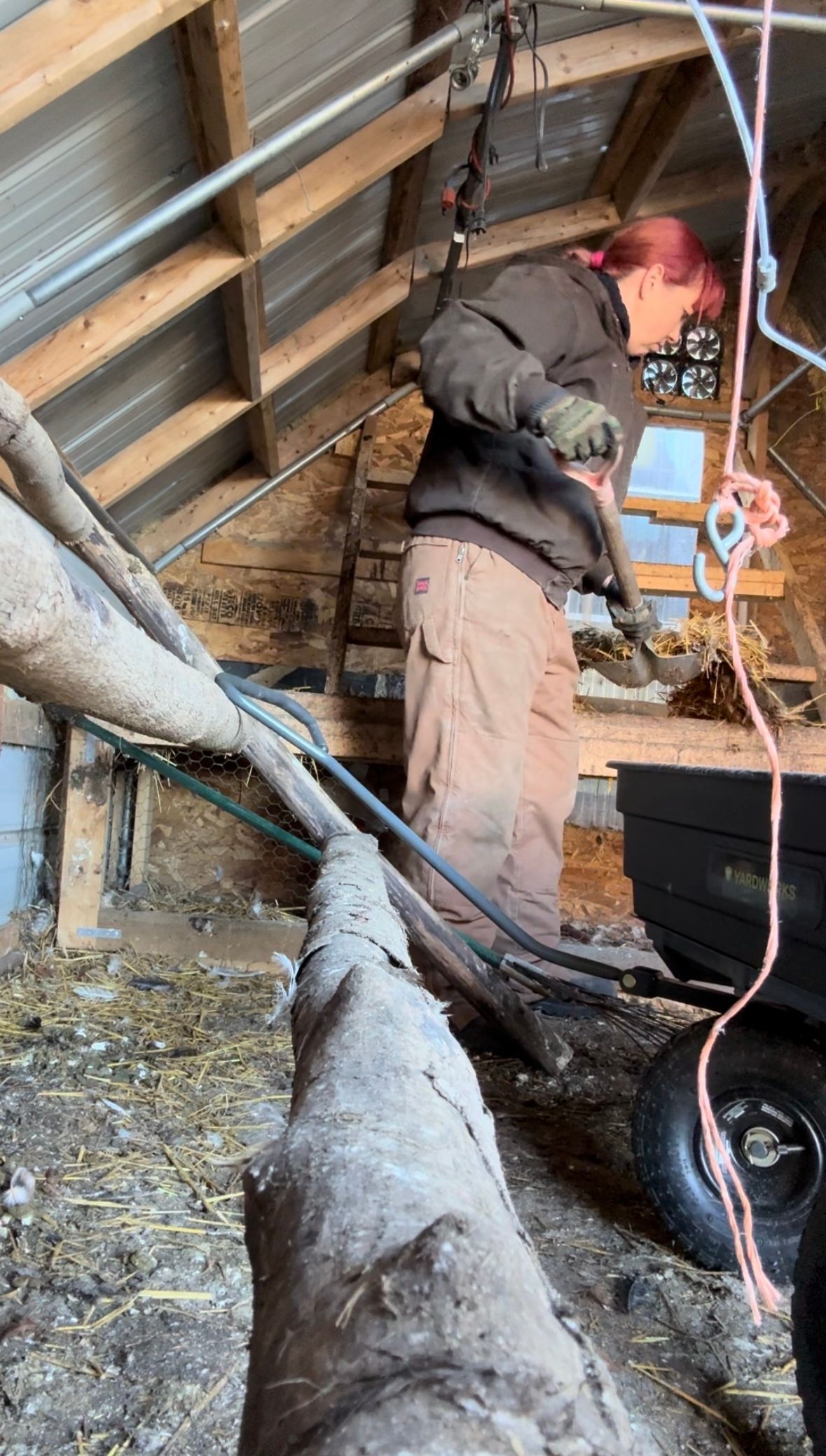

Keeping the Flock Warm and Healthy

Winter is just around the corner, and that means it’s time to prepare the chicken coop to keep my ladies warm, safe, and happy. Every coop and flock is different, and winterizing depends a lot on the climate, the setup of your coop, and your personal preferences. For me, this is winter number two with my current coop, which I built last summer using mostly leftover materials and a bit of creativity (more on that story another time).
Snow is on the way, and a cozy coop is essential for keeping chickens healthy through the colder months. When they’re happy and healthy, they return the favor by providing fresh eggs that help feed my family. Here’s how I winterize my coop and some tips to help you prepare your own.
1. Start with a Deep Clean
Before getting into winter prep, a thorough deep clean is crucial. I raked and shoveled out all the old bedding, dusted off surfaces, and removed any leftover debris from the summer months. A clean coop helps prevent the buildup of harmful bacteria and pests that thrive in damp, dirty conditions. The best purchase I have made to assist with the clean out is a
dump cart.
The coop was built with clean out in mind, I simply wheel the wagon in, fill it, pull it out and dump it into my compost pile.
2. Know Your Temperature Ranges
Chickens are surprisingly hardy birds and can tolerate a wide range of temperatures, but there are limits:
- Safe Temperature Range: Chickens are comfortable in temperatures between 32°F (0°C) and 70°F (21°C). They can handle colder weather as long as their coop is dry, draft-free, and well-ventilated.
- Dangerous Temperatures: When temperatures drop below 20°F (-6°C), chickens are at greater risk of frostbite, especially on combs and wattles. Extended exposure to extreme cold can also weaken their immune systems.
- Frostbite Risks: High humidity in the coop can exacerbate frostbite issues, even at moderate cold temperatures, so ventilation is key.
We keep a thermometer in the coop that wirelessly connects to a monitor inside our house, as well as a an outdoor thermometer to closely monitor the temperature inside the coop.
3. Insulate for Warmth Without Trapping Moisture
I added insulation to the walls to reduce drafts while keeping a balance with proper ventilation. Chickens produce a surprising amount of moisture from their breathing and droppings, so leaving upper vents open is essential to prevent dampness and frostbite.
- Insulation Placement: I filled in gaps around the walls where summer airflow comes through but left openings at the top of the coop to allow for air exchange.
- Skylight: I built in a skylight when I constructed the coop, which adds natural light and a bit of passive warmth during the day.
4. The Deep Litter Method
I rely on the deep litter method to provide natural insulation and even a little warmth as the bedding composts. Here’s how it works:
- After the cleanout, I added a thick layer of straw on the coop floor, in the nesting boxes, and even on the “poop table.”
- Each week, I mix the litter to aerate it and add another layer of straw. As the organic material breaks down, it generates a small amount of heat—enough to make the coop cozier on chilly days.
- Bonus: In the spring, the composted litter makes an excellent addition to the garden!
5. Water Management
Ensuring access to fresh, unfrozen water is critical during the winter months. Chickens need constant hydration to stay healthy.
- Heated Waterers: Invest in a heated waterer to prevent water from freezing.
- DIY Solution: Place a small plastic ball, like a ping pong ball, in the waterer. It moves slightly with the breeze, which can help delay freezing in milder conditions.
- Regular Checks: If heated waterers aren’t an option, check water bowls frequently and replace ice with fresh water as needed.
6. Feed Adjustments
Chickens burn more energy in winter to stay warm, so their diet may need a boost.
- Higher-Calorie Feed: Adding cracked corn to their diet before roosting helps them generate extra warmth overnight.
- Supplements: Offering scratch grains or additional protein sources can support their increased energy needs.
- Late Feeding: Feeding closer to evening can help keep their metabolism going and generate heat as they digest.
7. Coop Design Enhancements
Winterizing isn’t just about adding insulation; coop design plays a major role in keeping chickens comfortable.
- Roosting Bars: Elevate roosts at least 2-3 feet off the ground. Wider roosting bars (about 2 inches wide) let chickens cover their feet with their feathers, reducing frostbite risk.
- Ventilation: Ensure upper vents are clear to allow moisture to escape without letting cold drafts blow directly on the birds.
- Nest Box Prep: Add extra bedding to nesting boxes to keep eggs from freezing and encourage hens to lay consistently.
8. Heat Lamps: Proceed with Caution
Heat lamps can be a controversial topic among chicken keepers due to fire hazards. While chickens are naturally equipped with a down coat to keep themselves warm, I do use two heat lamps in my coop. However, I only turn them on during the coldest nights when temperatures plummet to dangerous levels.
- Why Sparing Use is Important:
If chickens become accustomed to the heat, they can struggle to acclimate to the cold, increasing the risk of frostbite or illness if the power goes out.
- Alternative Options: Some chicken keepers use
heated perches or
ceramic heaters to provide targeted warmth without drastically altering the coop’s temperature.
9. Predator Proofing
Winter can drive predators to become more daring in search of food. A secure coop is essential to protect your flock.
- Inspect for Gaps: Check for small openings where weasels or other predators could enter.
- Secure Latches:
Ensure all doors and windows close tightly and are reinforced.
- Hardware Cloth: Cover any vents or openings with hardware cloth to keep predators out without blocking airflow.
10. Freedom to Roam
Even in winter, I let my chickens decide whether they want to go outside. I crack the door just enough for them to come and go as they please. Most chickens are pretty hardy and enjoy exploring a snow-dusted run, but they’ll return to the coop when they need a warm-up. This freedom keeps them active and helps reduce boredom during the long winter months.
Final Thoughts
Winterizing the chicken coop isn’t just about keeping the flock warm—it’s about creating a safe, healthy environment that prevents illness, keeps eggs coming, and reduces stress on your birds. By maintaining the right temperature range, ensuring proper ventilation, managing water and feed, and keeping predators at bay, you can help your chickens thrive through the colder months.
So far, the ladies seem happy with their setup, and I’m looking forward to watching them enjoy the winter months while staying cozy and cared for. If you’re getting your coop ready for winter, I hope these tips help you and your flock thrive!
More Dawn's Simple Life inspirations
